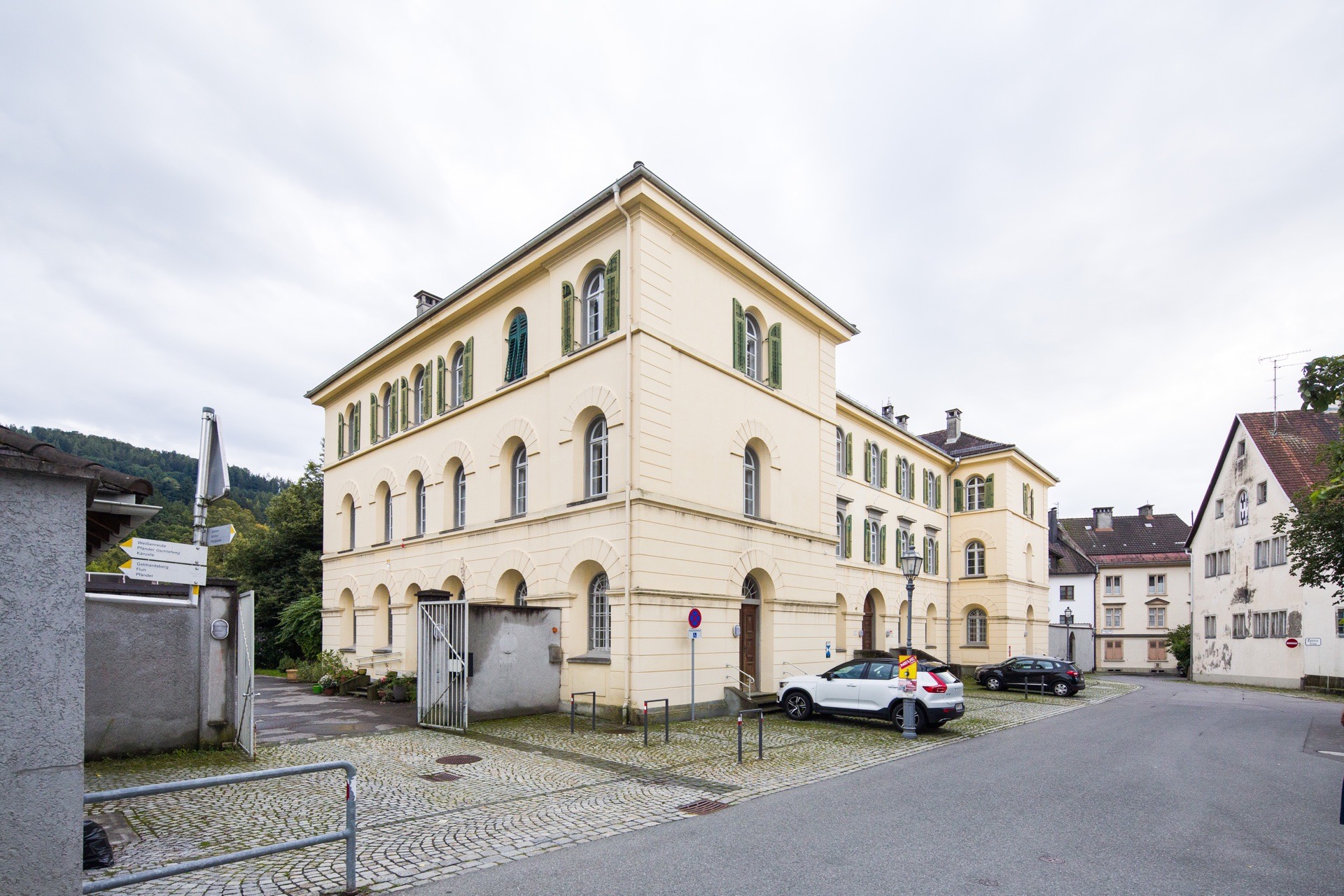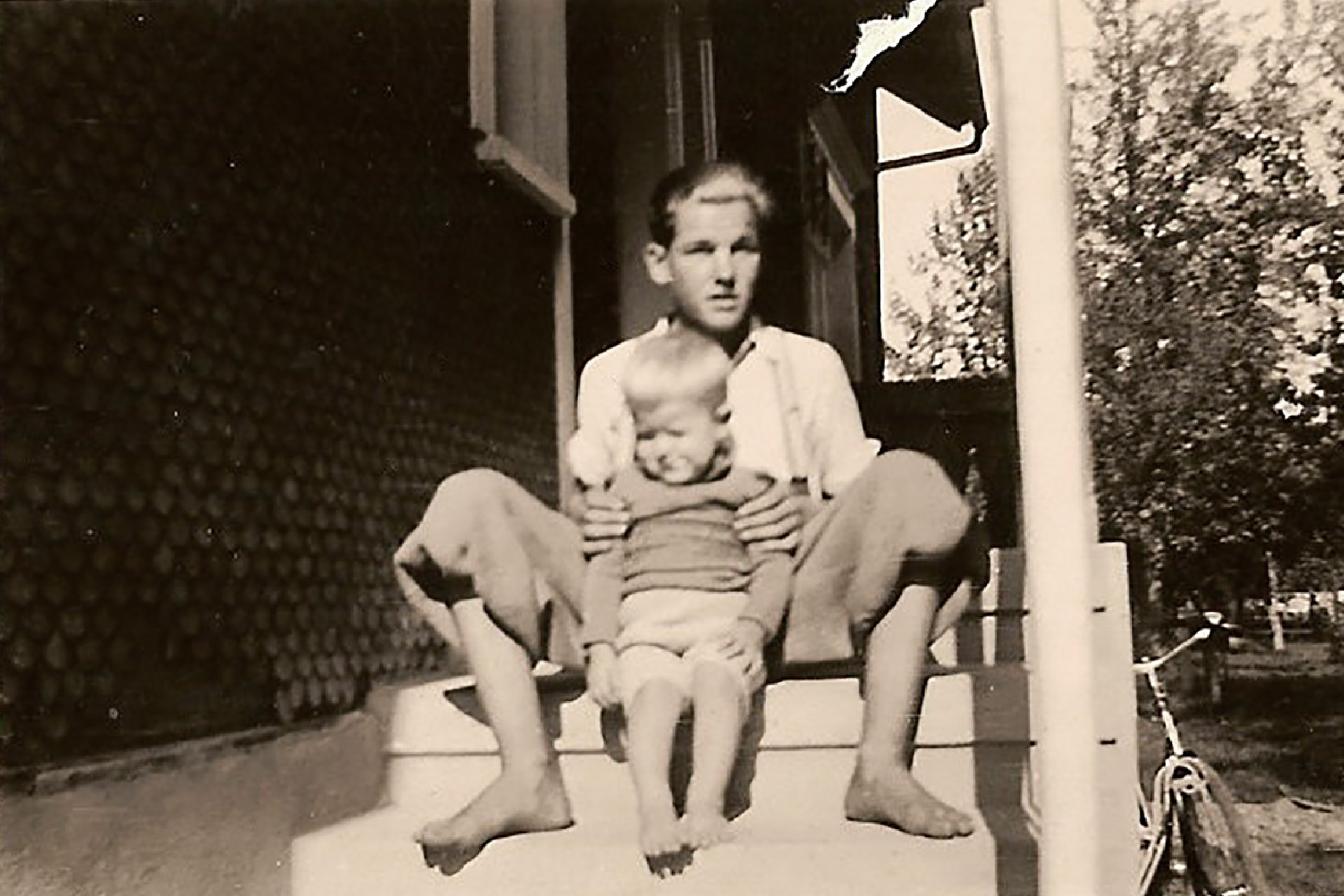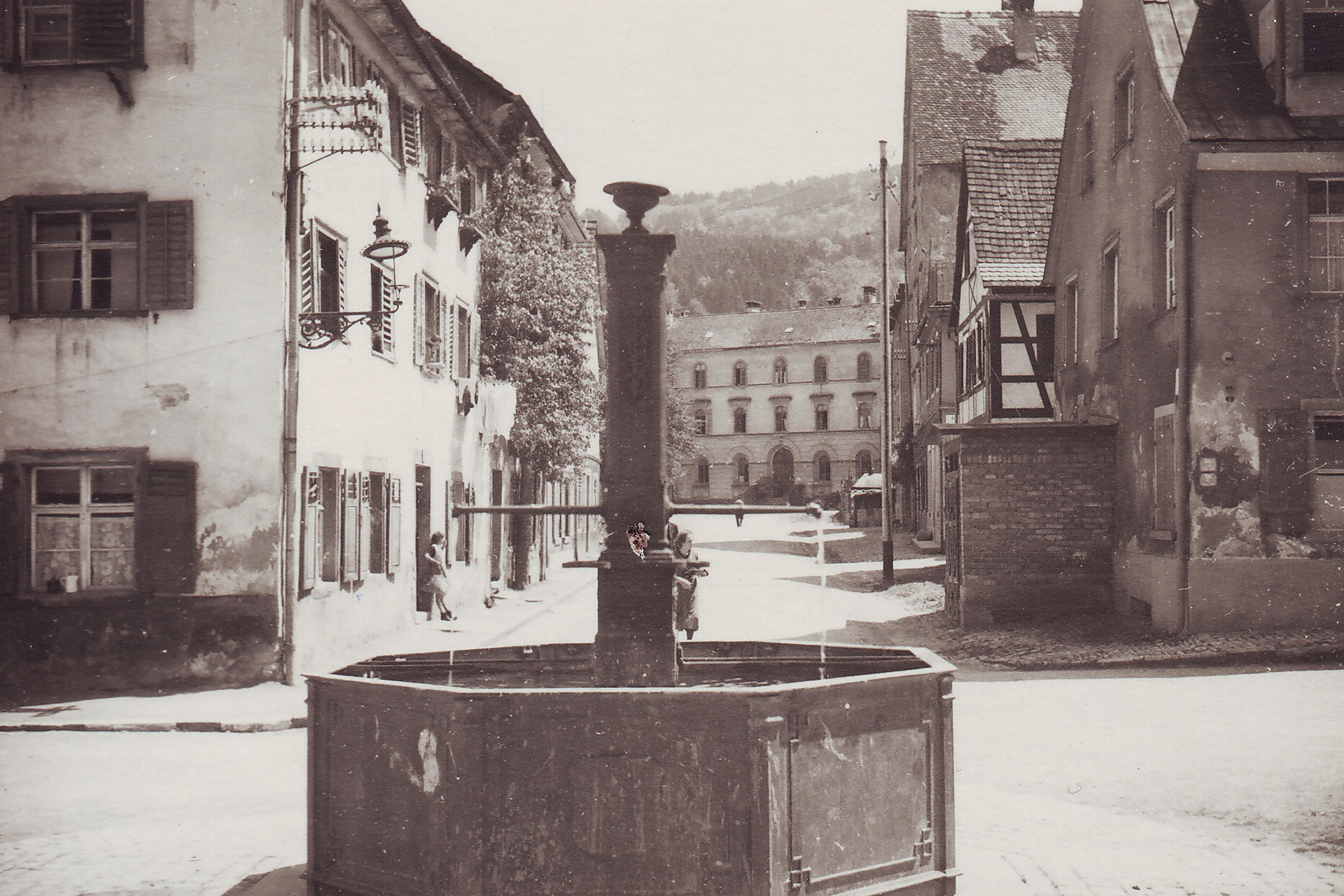Hilar Huber> August 26, 1941
4 Hilar Huber
Escape from the prison: the odyssey of Hilar Huber
Bregenz, August 26, 1941
In August 1941, a soldier is kept in the prison in the upper town of Bregenz who has already had an adventurous odyssey – and still has a long way to go. Hilar Huber's escape from prison was not to be his last. In 1943, he was put on trial in Innsbruck. The minutes of the trial against him reveal how he escaped from prison in Bregenz in August 1941.
“On August 26, 1941 Huber used the opportunity of the prisoners' walk in the courtyard of the Bregenz District Court Prison to suddenly jump onto the base of the wall under a window and from there onto the window sill, then to climb up on its iron grid, to pull himself up on the barbed wire, to swing himself through an opening in the wire enclosure onto the enclosure wall and then to let himself down on the outside of the enclosure on the climbing plants and thus to get out into the open.”[1]
The prison at Amtsplatz 1 in the upper town of Bregenz, where a total of around 7,000 people were imprisoned between 1938 and 1945, continued to operate until 1975. The prison wing itself consisted of 24 cells of various sizes and a washroom. In addition, there was a workshop and a kitchen with a storeroom. The hygienic situation was catastrophic. The run-down building, which would normally have been designed for a maximum of 50 inmates, was regularly overcrowded with up to 80 prisoners. The Bregenz Gestapo wanted to keep the people they arrested nearby for interrogation and not transfer them to the larger prison in Feldkirch. The “interrogations”, which were often carried out in a psychologically and physically violent manner, usually took place in the Gestapo offices in the nearby Römerstraße.
The prison warden was Johann Schmidinger, who had already been an illegal Nazi Party member before the so-called “Anschluss”. After an official criminal trial in February 1940, he was dismissed for abuse of his position and replaced by Baptist Schneider. But even under Schneider, food that was actually intended for the prisoners disappeared into dark channels, with fatal consequences for the prisoners' diet.
Escape attempts from the prison, whose security measures were not designed for the overcrowded cells, took place again and again during the Nazi dictatorship. Most of them were stopped on the spot or thwarted at the latest in the city.
But Hilar Huber, a soldier from Höchst a village near the lake, actually managed to break out on August 26, 1941. In October 1940, he was drafted by the Wehrmacht for training and in the spring of 1941, he was transferred to the Balkan front with the Innsbruck Mountain Infantry Battalion. Huber's escape began there at the end of May. He left his troop stationed in Atalanti, Greece, and made his way on foot to Skopje. From there he continued his way to Vorarlberg by bicycle and reached Villach, where he changed to the railway for the last stage. On June 24, 1941, he finally got off the train at the Hohenems railway station and reached his parents' home in the evening after about 2,000 kilometres and four weeks.
Huber reports for Wehrmacht leave and works as a bricklayer for a month before he is arrested at his workplace. When he realized after an interrogation in Bregenz that he would soon be transferred to a military prison, he dared to escape.
With a bicycle stolen in Bregenz Vorkloster, Huber quickly reaches the border near Gaißau, where he finally swims the Old Rhine near Rheineck into Switzerland. However, he does not remain free for long. His uncle living in Switzerland reports him to the authorities. Two weeks later, Huber is taken into custody in the St. Gall police prison and interrogated several times. He was then transferred to the Witzwil prison in the canton of Bern and then to the Murimoos internment camp in the canton of Aargau. He managed to escape from the latter again in November 1942.
Now he wanted to go to the Jura to a friend. But he was arrested in Biel and escaped again. Resigned, he returned illegally to Vorarlberg. And there he was arrested again. On the 3rd of March 1943 in Innsbruck he was sentenced to death for desertion.
But his story does not end here. Ten days later, the death sentence is changed to a 15-year prison term. The German Reich runs out of soldiers. He is to begin his imprisonment in the Lingen concentration camp in the Emsland region of northern Germany. But even there he manages to escape again after only three days. Via Kaufbeuren, the Lechtal, the Bregenzerwald, Ebnit and Götzis, he reaches Altach, on the Rhine. Twice he is arrested on the way and twice he manages to escape. And again he makes it to Switzerland illegally. He made it as far as Winterthur – where he was arrested for the eighth time. In January 1944, he dares to escape for the last time – and is initially successful again. But his way to Italy ends in Glarus in the clutches of the Landjaeger. He spends the time behind bars in Switzerland until the end of the war.
Released from prison without much ado, he crossed the bridge between St. Margrethen and Höchst in May 1945 and returned to Vorarlberg for good – and to a far less exciting life after the war. He works in construction, and in old age he retires to a hut he built himself in the Lustenauer Ried. Hilar Huber dies, aged eighty, in 2001.
The prison in the upper town has been used after extensive reconstruction by the Federal Monuments Office since the 1980s.
Recommended reading:
Meinrad Pichler, „Grenz-Erfahrungen. Die Fluchten des Hilar Huber (1920-2021) aus Höchst“, in: Pichler, Quergänge. Vorarlberger Geschichte in Lebensläufen, Hohenems 2008, pp. 300 - 314.
Links:
On the occasion of the Bodenseekirchentag 2002, a memorial path was installed in the city area of Bregenz with nine plaques commemorating people in Bregenz who resisted National Socialism or were victims of racist and anti-Semitic persecution.
https://www.erinnern.at/media/552bdd0f079b9d170c74c85f66e5dfb8/gedenkweg-pdf
[1] Court proceeding protocol (kept at Dokumentationsarchiv des Österreichischen Widerstands), quoted from: Meinrad Pichler, „Grenz-Erfahrungen. Die Fluchten des Hilar Huber (1920-2021) aus Höchst“, in: Meinrad Pichler, Quergänge. Vorarlberger Geschichte in Lebensläufen, Hohenems 2008, p. 300-314, here p. 302.
4 Hilar Huber
Escape from the prison: the odyssey of Hilar Huber
Bregenz, August 26, 1941
In August 1941, a soldier is kept in the prison in the upper town of Bregenz who has already had an adventurous odyssey – and still has a long way to go. Hilar Huber's escape from prison was not to be his last. In 1943, he was put on trial in Innsbruck. The minutes of the trial against him reveal how he escaped from prison in Bregenz in August 1941.
“On August 26, 1941 Huber used the opportunity of the prisoners' walk in the courtyard of the Bregenz District Court Prison to suddenly jump onto the base of the wall under a window and from there onto the window sill, then to climb up on its iron grid, to pull himself up on the barbed wire, to swing himself through an opening in the wire enclosure onto the enclosure wall and then to let himself down on the outside of the enclosure on the climbing plants and thus to get out into the open.”[1]
The prison at Amtsplatz 1 in the upper town of Bregenz, where a total of around 7,000 people were imprisoned between 1938 and 1945, continued to operate until 1975. The prison wing itself consisted of 24 cells of various sizes and a washroom. In addition, there was a workshop and a kitchen with a storeroom. The hygienic situation was catastrophic. The run-down building, which would normally have been designed for a maximum of 50 inmates, was regularly overcrowded with up to 80 prisoners. The Bregenz Gestapo wanted to keep the people they arrested nearby for interrogation and not transfer them to the larger prison in Feldkirch. The “interrogations”, which were often carried out in a psychologically and physically violent manner, usually took place in the Gestapo offices in the nearby Römerstraße.
The prison warden was Johann Schmidinger, who had already been an illegal Nazi Party member before the so-called “Anschluss”. After an official criminal trial in February 1940, he was dismissed for abuse of his position and replaced by Baptist Schneider. But even under Schneider, food that was actually intended for the prisoners disappeared into dark channels, with fatal consequences for the prisoners' diet.
Escape attempts from the prison, whose security measures were not designed for the overcrowded cells, took place again and again during the Nazi dictatorship. Most of them were stopped on the spot or thwarted at the latest in the city.
But Hilar Huber, a soldier from Höchst a village near the lake, actually managed to break out on August 26, 1941. In October 1940, he was drafted by the Wehrmacht for training and in the spring of 1941, he was transferred to the Balkan front with the Innsbruck Mountain Infantry Battalion. Huber's escape began there at the end of May. He left his troop stationed in Atalanti, Greece, and made his way on foot to Skopje. From there he continued his way to Vorarlberg by bicycle and reached Villach, where he changed to the railway for the last stage. On June 24, 1941, he finally got off the train at the Hohenems railway station and reached his parents' home in the evening after about 2,000 kilometres and four weeks.
Huber reports for Wehrmacht leave and works as a bricklayer for a month before he is arrested at his workplace. When he realized after an interrogation in Bregenz that he would soon be transferred to a military prison, he dared to escape.
With a bicycle stolen in Bregenz Vorkloster, Huber quickly reaches the border near Gaißau, where he finally swims the Old Rhine near Rheineck into Switzerland. However, he does not remain free for long. His uncle living in Switzerland reports him to the authorities. Two weeks later, Huber is taken into custody in the St. Gall police prison and interrogated several times. He was then transferred to the Witzwil prison in the canton of Bern and then to the Murimoos internment camp in the canton of Aargau. He managed to escape from the latter again in November 1942.
Now he wanted to go to the Jura to a friend. But he was arrested in Biel and escaped again. Resigned, he returned illegally to Vorarlberg. And there he was arrested again. On the 3rd of March 1943 in Innsbruck he was sentenced to death for desertion.
But his story does not end here. Ten days later, the death sentence is changed to a 15-year prison term. The German Reich runs out of soldiers. He is to begin his imprisonment in the Lingen concentration camp in the Emsland region of northern Germany. But even there he manages to escape again after only three days. Via Kaufbeuren, the Lechtal, the Bregenzerwald, Ebnit and Götzis, he reaches Altach, on the Rhine. Twice he is arrested on the way and twice he manages to escape. And again he makes it to Switzerland illegally. He made it as far as Winterthur – where he was arrested for the eighth time. In January 1944, he dares to escape for the last time – and is initially successful again. But his way to Italy ends in Glarus in the clutches of the Landjaeger. He spends the time behind bars in Switzerland until the end of the war.
Released from prison without much ado, he crossed the bridge between St. Margrethen and Höchst in May 1945 and returned to Vorarlberg for good – and to a far less exciting life after the war. He works in construction, and in old age he retires to a hut he built himself in the Lustenauer Ried. Hilar Huber dies, aged eighty, in 2001.
The prison in the upper town has been used after extensive reconstruction by the Federal Monuments Office since the 1980s.
Recommended reading:
Meinrad Pichler, „Grenz-Erfahrungen. Die Fluchten des Hilar Huber (1920-2021) aus Höchst“, in: Pichler, Quergänge. Vorarlberger Geschichte in Lebensläufen, Hohenems 2008, pp. 300 - 314.
Links:
On the occasion of the Bodenseekirchentag 2002, a memorial path was installed in the city area of Bregenz with nine plaques commemorating people in Bregenz who resisted National Socialism or were victims of racist and anti-Semitic persecution.
https://www.erinnern.at/media/552bdd0f079b9d170c74c85f66e5dfb8/gedenkweg-pdf
[1] Court proceeding protocol (kept at Dokumentationsarchiv des Österreichischen Widerstands), quoted from: Meinrad Pichler, „Grenz-Erfahrungen. Die Fluchten des Hilar Huber (1920-2021) aus Höchst“, in: Meinrad Pichler, Quergänge. Vorarlberger Geschichte in Lebensläufen, Hohenems 2008, p. 300-314, here p. 302.



